#queer readings
Text
I have thoughts about Able and Tron
Okay so. Able *cannot* be from the first grid, the ENCOM grid, right? Like, idk he just can’t be. Why would Flynn port over some random mechanic.
And yet. In the second episode Able reveals he has a FIRST GEN LIGHT BIKE. Y’KNOW. FROM THE ENCOM GRID.
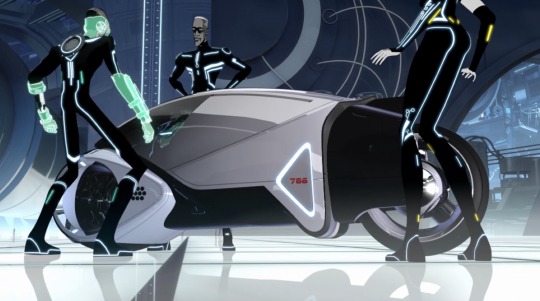
(Interesting to note is that Mara distinctly says it’s “one of a kind” when she observes it)
And then notice how Tron *never* rides a first gen light bike in the show, even in the flashbacks, despite being the most likely to own one considering he comes from the ENCOM grid.
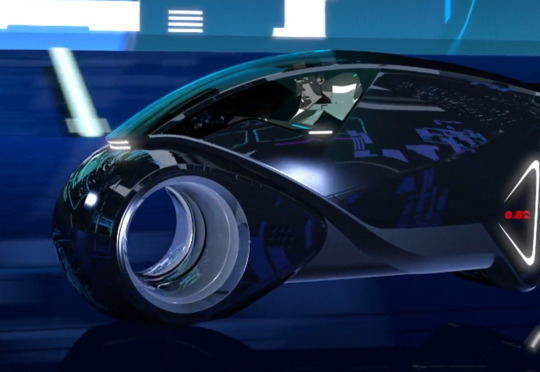
DID. DID TRON GIVE ABLE HIS “one of a kind” LIGHT BIKE??
Take into account that Able really likes that bike. Sure it’s an old thing so ofc he would, but still. Able calls it his favorite bike.
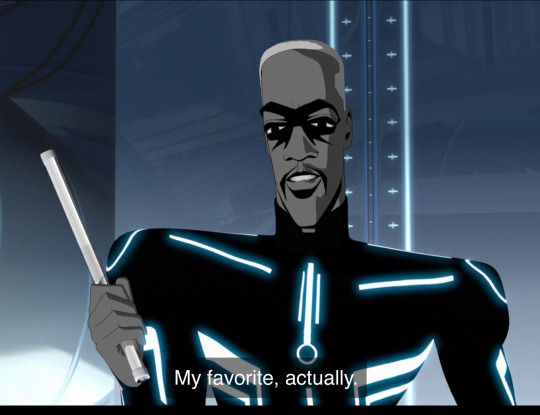
Remember that Tron isn’t one to show his affection through words, rather in actions (Beck has to be on the brink of losing his memories for him to finally call him his friend).
Able also has a Bit. Again, something from the ENCOM grid, and while it seems the Bit belongs to everyone in the garage, it’s often seen in Able’s office. It even has its own stand.
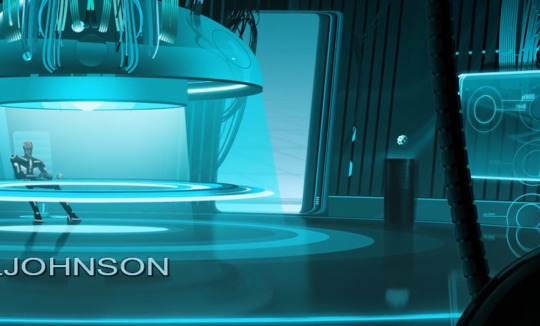

Where does he get these things? Is it another thing Tron gave him? There’s no currency to speak of in the Grid (I can only imagine the black market for stolen disks is to get in favor with the Occupation by providing the disks of wanted programs. Energy is simply a resource, not a currency), he couldn’t have ‘bought’ it anywhere.
Tangentially related, I know that people have noticed the Yori suit Easter egg, but I haven’t seen many think about the implications of Able having it in his office.
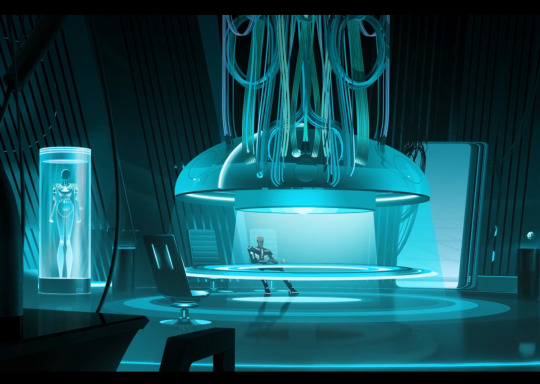
Why would he? Tron has enough space at his place to store the suit if he wanted to. Why put it in Able’s office? Does it imply Able had some sort of relationship with Yori? Does it imply he’s thinking about her at the start of episode 12? Why does Tron keep giving Able things and why does he trust him to such an immense degree to keep the suit of his former lover in his office? That seems like a huge thing to trust Able to keep, especially considering how Able and Tron’s relationship is shown to be strained at best.
Pair this with the fact they’re often portrayed as a bickering couple talking about a program who fills a surrogate son role, and you got me smelling queerness imma be real.
Either this is a kinda unusual way to imply a history between Tron and Able before the reveal, or they’re queer as fuck (maybe even both).
#I’m sure it’s the former of the two options I mentioned at the end#but idk man#maybe a lot of people already made the connection between the stuff Able owns and his relationship with Tron but idc I *just* figured it ou#t#queer readings#am I crazy for looking too hard into this idk#am I jumping to conclusions? maybe. maybe there’s a completely heterosexual explanation for this but that’s not gonna stop me#tron#tron uprising#i ramble#tron able
66 notes
·
View notes
Text
I think it’s important to remember that straight ships are just as valid as queer ships!! I know in some of my queer friends there’s a knee-jerk instinct to make sure that their main ships are reflections of themselves or other part of the queer community (which is valid!), but in the same breath will dismiss or cringe at a heterosexual ship— especially if the heterosexual ship is being implied as cannon in the text.
It’s an important part of the queer normalisation sequence that cis and het ships and characters are fine and normal!! And that there’s a difference between not shipping something based on preference vs political/social standings
— <3
#yes this post is about Spider-Man#it’s just something I find as a trend online#one can love cis-het AND queer ships in the same brain#I lobe spider ppl#into the spider verse#across the spiderverse#Spider-Man#punkflower#gwen stacy#spider gwen#miles morales#queer community#queer readings#homosexual#heterosexual#straight#gay pride#gay#pavitr prabhakar#gayatri singh#hobie brown#chaipunk#chaiflower#ghostflower#ghostchai#ghostpunk
89 notes
·
View notes
Text
Naminé & Roxas Are Twins
(this meta was inspired by @violethowler's Constructing Kingdoms series on YT)
In KH2, the relationship between Sora & Roxas is seemingly paralleled with that of Naminé & Kairi. It is explained by characters in-game that Naminé, a Nobody, must have been created by Kairi's presence in Sora's Heart during KH1. Thusly is it concluded that Naminé must be the Nobody of Kairi, another facet of that Princess of Heart.
Except... Kairi is a Princess of Heart: a being of pure light, without any Darkness of her own. It is physically impossible for Naminé to be Kairi's Nobody.
At no point has Kairi exhibited the capacity to hold Darkness. Kairi's lack of Darkness is, arguably, one of the major reasons for her lack of combat prowess: without "darkness" of her own, Kairi is unable to feel the selfishness needed to hurt others. This is a small, fundamental kind of Darkness that all living things carry: without it, a Princess of Heart is all too essily incapacitated by selflessness.
Naminé isn't (can't) be Kairi's Nobody: she, like Roxas, is a Nobody of Sora & Ventus. Naminé and Roxas are twins.
Roxas and Naminé are unlike any other Nobody within the KH setting: they alone were capable of developing "selfhood", independently from their Hearts of origin. This is due to the many unique circumstances of their birth: Sora's self-sacrifice in KH1. That event featured multiple oddities likely to affect Sora's Heart, Heartless & the Nobodies created: self-sacrifice (love); heartlessness via keyblade; the specific keyblade used (the Keyblade of [People's] Hearts); the origin of said keyblade (Riku the ???, the person Sora likely loved most at the time); the presence of Kairi, a Princess of Heart, within Sora's Heart; the presence of Ventus, an artificial "Princess of Heart"; the location of the sacrifice (Ansem's Lab in Hollow Bastion, a World fallen to Darkness)... and likely even more factors, known & as yet unaddressed.
As twin Nobodies to Sora's Heartless, Roxas & Naminé were affected by all variables noted above. Sora has been the Host of several Hearts for his entire life: that makes him special, even before Riku chose Sora to be a keyblade wielder. I venture that the Heart most relevant to Naminé's birth was not Kairi's but Ven's: for where Roxas most resembles Sora in disposition, Naminé resembles Ventus-without-Vanitas. Kairi's presence within Sora's Heart had effects, yes, but less than perhaps understood.
The misunderstanding, I argue, comes largely from Kairi's longterm role of "Designated Female": as the lone KH-original female for much of KH's early development (& popularity), Kairi is often considered a "default option" with regards to all things feminine. This feeds not only into assumptions of a Kairi-focused love triangle but also into an overinflation of Kairi's presence in the story.
As with Xion, Naminé's true identity is obscured, in-game & within fandom, by her gender: "Xion & Naminé are female; the only female in proximity to this plotline is Kairi: Xion & Naminé must therefors be derivative personas of Kairi".
Here, as always, Kairi serves as a convenient "default" of femininity, misdirecting players and characters from the queer potential within KH. It is wholly believed, by Sora & the girls in question, that Naminé was Kairi's Nobody. Yet, it is never Kairi whose story and character is most expanded by Naminé's involvement: Naminé's story is, instead, a follow-up to that of BBS's Ventus.
Kairi struggles with a forgotten past, loss & a resistance to change (of "growing up"). Naminé, in parallel & in contrast, experiences the kind of life that Kairi has forgotten: [medical abuse], extortion & isolation. Naminé's time with Organization XIII & with DiZ mirrors that of VEN's with Master Xehanort (&, to a lesser degree, with Master Eraqus).
Kairi's history as a test subject of Xehanort &, possibly, of Ansem the Wise? She's forgotten it and, outside of Melody of Memories, we never get to see how it affected her. Kairi's Ambiguously Traumatic Past is only ever used for her in her role as "MacGuffin" (i.e. an object of plot importance & no other story-relevant function, one that is ultimately interchangeable with). Kairi's story barely affects Naminé's & Naminé's doesn't affect Kairi's either: the characters most changed by Naminé's character arc were Sora & Riku. This further alludes to Naminé not truly originating from Kairi's Darkness but from Sora-Ven.
The duality of Sora-Ven is reflected in Sora's producing two distinct ("twin") Nobodies during KH1. Roxas is most reflective of Sora but physically looks like Ventus; Naminé is most reminiscent of Ventus-without-Vanitas but (allegedly) "looks like Kairi": this does not occur in the Nobodies of other hybrid-beings, as evident in Xemnas (Terra & Xehanort) & Xigbar (Braig & Luxu). In this way, Naminé & Roxas are more akin to Xion than most every other Nobody.
Ignoring the gender binaries (canonically used & assumed in-universe), the characters that Naminé actually resembles are Ventus (who I propose as Naminé's "primary" origin) & Xion (another artificial being with Sora Origins).
Narratively & thematically, Naminé's arc from CoM to KH2 was a continuation of Ven's story in Birth By Sleep. Both characters are strongly tied to themes of isolation, abusive authority figures, and artificial life. While other characters - Xion, Repliku & Terra-Xehanort - also explore these themes, Kairi notably does not.
I will note that Naminé does not NEED to be Kairi's Nobody to act as her narrative foil: I just find that identifying Naminé with Kairi is buying into the very same (false) Binaric Gender Roles that CoM, Days & (to a lesser extent) BBS sought to poke holes in. Tiny, easily mistranslated-into-nonexistence holes but holes nonetheless. Attempting to conflate Naminé with Kairi is to give the latter character more narrative presence than she truly has, in an effort to reconcile the two together beyond "similarly aged females in proximity to KH's plot".
#kh meta#kh nobodies#naminé#naminé and roxas are twins#naminé is ven's nobody#kairi the character#kairi the designated female#female characters in kingdom hearts#princesses of heart#sora's heart hotel#kairi & naminé#ventus & naminé#kh theories#queer readings#this is two different essays/theories merged into two: “quality” shifts notably#edit later
14 notes
·
View notes
Text
Queering Steed
A few thoughts I been thinking, with the obvious caveat that these are just my thoughts and are neither comprehensive nor meant to be the sole reading. I'd really just like to have the discussion.
Placing a queer reading on Steed is entirely legitimate, but I think it can carry with it some assumptions about gender and sexuality that actually becomes slightly more regressive than is intended.
Obviously, The Avengers aired during a time when you could not have explicitly queer characters in mainstream TV or film. So any depiction of queerness—essentially anything that was not aligned with heteronormative culture—had to be placed in subtext, to greater and lesser degrees. This leaves out the intentionality of the writers/producers themselves in conceiving of Steed, and very likely of Patrick Macnee himself. Steed, onscreen, cannot be gay.
Steed's nearest secret agent counterparts are James Bond, himself a deeply stereotypical male role, complete with aggressive misogyny, and Napoleon Solo, less stereotypical and aggressive, still relatively sexist. Bond himself was supposed to be a model for Steed, which Macnee dismissed out of hand. The Avengers increasingly and deliberately played with gendered and sexual stereotypes, subverting established roles. This in itself reads as queering the characters, to a degree, because they're stepping outside of heteronormative assumptions about masculine and feminine roles. Later seasons come to rely on camp aesthetics to further enforce the heightened, comedic nature of the show and its relationships.
But I think that part of the success of The Avengers was in showing ostensibly heterosexual characters relating to each other outside of heteronormative roles. Steed clearly sleeps with women - early episodes show him dating women, flirting with women, and imply that he goes to bed with women. But he is also represented as a heterosexual man who sees women as equals, in direct contradiction to his nearest secret agent brethren. He is represented as a heterosexual man who can be bested by a woman without it reducing or "questioning" his masculinity, either for himself or for the audience. Steed is represented as a heterosexual man who is not a danger to women—he is not going to harm, assault, attempt to seduce (or rape) any woman who comes within his orbit.
Steed's implied heterosexuality I think is important, at least as a potential reading (even if other potential readings are equally as valid in their own ways), because it is one of the few representations of a heterosexual male character, and a secret agent at that, whose heterosexuality is not dangerous or inherently predatory. He belies assumptions that straight men are "natural predators," the argument made by characters like Bond.
15 notes
·
View notes
Text
Sometimes you reread classic childrens lit for fun.
And sometimes you reread classic childrens lit to see which character best lends to a queer reading (I’m writing a sequel under public domain and I’m physically unable to have a cast of entirely straight characters).
And sometimes you’ve got to talk yourself out of the obvious answer. Because if only one of them is queer it can’t be Edmund or Susan. And if multiple of them are queer it can’t be Edmund AND Susan.
The focus group that lives in my head gave me a lot of feedback. (If you have an argument in favour of it being Edmund and/or Susan please tell me. I love them as characters, but I want to avoid….any unfortunate implications).
#TLTW&TW Sequel#fanfiction#public domain#the lion the witch and the wardrobe#susan pevensie#edmund pevensie#writing#writers problems#queer characters#queer readings#fanfic
10 notes
·
View notes
Text
Queer Readings of The Hobbit
I want to point out a fact I never really hear when reading arguments for BilboxThorin based on book evidence: Tolkien wrote The Hobbit 17 years before he wrote The Lord of the Rings, in a time when fantasy writing was considered inappropriate except as children’s stories. As such, Tolkien specifically tailored his story for children and I would argue The Hobbit suffered for it. It’s truly funny, but often condescending towards it’s (child) reader. It starts lighthearted and absurd but the ending is so devastating it’s downright alienating. This inconsistency, to me, is evidence that Tolkien was having trouble reconciling his complex themes with the limitations of the genre.
In a children’s story, Tolkien would not have had the freedom to explore the breaking down of boundaries between class, race and gender the way he later could in LOTR. He couldn’t explore the various ways to portray love. He does all of this later, drawing parallels, leaving room for ambiguity- but he wouldn’t have been able to do that without first writing The Hobbit, which opened the door for a more adult sequel.
I think it’s also important to point out that the Hobbit was written in the years leading up to WWII and LOTR was written ten years after WWII finished. Two very different worlds.
Tolkien wanted to go back and re-write The Hobbit with a more serious adult tone, and more in keeping with the lore and mythology of Middle Earth he was creating. He even got about a third of the way through before a friend discouraged him, saying it would take away the “charm” of the first version. And yes, I’m sure that is true. The Hobbit is charming and hilarious. I would never want to lose the incredible first version that we all know and love.
Still, I can’t help but wonder about the version Tolkien wanted to write later on, once he was freer to address more adult themes and wasn’t limited in his subtlety to what a child could comprehend. Would there have been more ambiguity between Bilbo and Thorin in their interactions, the way there is between Frodo and Sam?
And, as a side note, I can’t help but wonder, would it have ended differently? Would he still have killed off three of the line of Durin in a heavy-handed attempt to moralize about greed? Or would he have tried for something more subtle (although, knowing Tolkien, probably no less painful)?
I know this is all conjecture but all I’m arguing for is possibilities- I think that’s all we queer folk are arguing for at the end of the day: the possibility to exist, to have existed, and to continue to exist. Tolkien made space for possibilities in his later works- and I’m arguing that he would have wanted to for The Hobbit, as well. ♥️
#bagginshield#the hobbit#Tolkien#Bilbo#Thorin#queer readings#reading the hobbit#lotr#queer#frodo and sam#thorin oakenshield#bilbo baggins#ambiguity#samfro#frodo baggins#samwise gamgee#lotr meta#the hobbit meta
139 notes
·
View notes
Text
I'm so tired of queer readings being just gay readings.
I want to make it clear that im not saying gay readings aren't queer ones or that they aren't valid interpretations, I'm specifically critiquing how gay readings are the vast majority made, despite queer encompassing so much more. What's worst is when people deny or ignore the other readings they'll quickly step into different types of queerphobia, with ace and biphobia being the ones I see most.
For example:
Two characters (usually dudes) in an ambiguous and noncomformative relationship can be read as aro and/or ace just as strongly as it can be read as gay. HOWEVER, the gay reading is the only one discussed (or acknowledged).
Or how about when a widely interpreted gay character ends up in a straight relationship or crush? People proclaim they lost a queer character while ignoring that Bi, pan and the other multi-atraction identities exist.
And this isn't even touching how trans reading are often seen through the gender binary or how Sapphic and, especially, Lesbian reading don't get an ounce of attention their male counterparts do, or how little any other identity I haven't mentioned is acknowledge in readings (or general).
In other words. Queer is more then gay and it would be nice queer readings were too.
#lgbtq#lgbtqia#lgbtq+#queer#queer readings#it would also be nice if you'd all stop using gay and synonym for queer#canine rambles
11 notes
·
View notes
Text
I’d hate to be a ‘both sides”-er, but I have nagging issues with how both especially dogmatic BKDK fans and hardcore antis often interpret the story, especially when it comes to Deku’s side of equation.
I agree antis are obtuse about Horikoshi’s emphasis on Deku’s affection for Bakugou, and how the latter is consistently used for certain story beats over other characters, but on the other hand, that and how Deku’s been keeping all this to himself don’t inherently guarantee the main cause is hidden romantic feelings. Another explanation could be that all those times Deku was basically helpless to save Bakugou traumatized the hell out of him, and it’s part of why he became so overprotective and reactive. His keeping those feelings to himself could easily just be the sadly typical tendency for teenage boys to keep serious mental health issues to themselves until they pop.
HOWEVER, I do enjoy queer interpretations of his character because I personally think repressed bisexuality is a good addition for almost any already-interesting storyline. Basically, “Wow, your problems are bad. Let’s see if we can make them worse.”
#I Could Make Him Worse#bnha#mha#my hero academia#kohei horikoshi#izuku midoriya#bakugou katsuki#deku#kacchan#bakudeku#dekubaku#decchan#bnha meta#mha meta#manga#anime#slash discourse#fandom#queer readings#fandom discourse#bisexuality#bisexuality in fiction
43 notes
·
View notes
Note
Coco ilu PLEASE drop the queer reading of Bunnicula essay 😭 hope ur having a good day, i am dying at the thought of (chester??) the cat looking at that tiny bunny sucking the red off an apple like 'i know what u are..'
!!!! I love you too, anon, omg, thank you so much for sending me such a delightful question! Had a surprisingly decent day as well, so I hope you had a great one too!
Thanks so much for asking me about Bunnicula - I read it in about second grade, after my 'introduction' to Dracula beyond pop culture was Dead and Loving It the year prior (and seeing Bela Lugosi clips on the old movies channels here and there), and this was a much more digestible, less terrifying experience of vampires for baby Coco.
First off, the "I know what you are" memes are funny, but genuinely, I think Chester the cat and Harold the dog were such an old married couple. They're not quite as acrid as Statler and Waldorf or as affectionate as Timon and Pumbaa, but the way they snark at each other, affectionately disparage one another's literary tastes, and tease about various neuroses, as well as playing Holmes and Watson for the mystery of the story speaks for itself! That Chester is the one who needs to overcome his prejudice of outsiders is an interesting wrinkle to this, but he's working on it through therapy and, literally, as the text says, "finding himself". I mean, if this isn't a gay cat unpacking his internalized issues and respectability politics with the help of the zanier Bunnicula and the more self-assured Harold, I don't know what is.
Next, there's Bunnicula himself; an homage to tropes of both classic vampire films and the trashy television fare of the mid-20th century, which is already historically very popular with queer people for many reasons - camp factor, the affinity many of the LGBTQ+ community towards horror, and especially how easily identifiable the vampire in particular is as a queer figure. The core message of the story is that of accepting and celebrating the differences of others; Bunnicula is indeed a vampire, but, being a vampire rabbit, only sucks the life out of vegetables and is therefore harmless - it's Chester's judgment of him making him an outsider that's the issue. (Sidenote that the concept is cute + funny + kid-friendly enough that it sidesteps the usual lame cop-out that is the vegetarian vampire.) The vampire as an outsider - and hence queer - is an age-old reading. Further, while there's definitely space for queer narratives of feeling like a monster and/or imperfect/toxic stories aimed at teenagers and adults, the vampire as specifically oppressed and in a work aimed at kids works uniquely well in this context since Bunnicula's harmlessness allows him to sidestep the usual conundrums of monster-posing-genuine-threat-as-stand-in-for-oppressed group (looking at you, Zootopia.). (Added addendum that while I mentioned narratives for kids having to exist in a simpler moral universe here, this 1:1 is an issue I have with many 'vampire as a stand-in for queer people' narratives -- True Blood/Southern Vampire Mysteries ran into it frequently, although otoh I found the latest Interview With The Vampire TV show to handle it with better nuance. It's tricky territory, to say the least)
The meta-narrative to this can't be ignored. The author, James Howe, came out as gay decades after writing this with his late first wife, Debbie, and has expressed many times that though he was closeted/uncertain at the time of writing the original novel, he on reflection must have subconsciously imbued it with themes of being a horror-loving, artistic, bullied outsider that reflected his own childhood experiences. Likewise, he's noted that Debbie, who was Jewish and had similar tastes and experiences, was probably doing the same. Since coming out, James Howe has engaged in extensive anti-bullying and equality-focused advocacy work, and has since made his priority incorporating themes of compassion towards the outsider in all his writings for kids - his later works have even featured canon gay characters. From what I've read, these themes have persisted through the rest of the Bunnicula series (though I think I only ever read the first book).
All this to say: Chester and Harold are married, Bunnicula is their flamboyant housemate.
3 notes
·
View notes
Text
writing projects /update
fic:
drarry/chaptered (in english). it will be deep. I will try not to make every character an intj, lol. /still outlining, will start writing when I’m not so busy with uni.
poetry:
constantly writing some little poetry (in spanish for now). will see where it ends up. If you speak Spanish and would like to read it eventually, hit me up.
“essays”:
long, extensive queer reading about drarry where I’ll be using every skill that i’ve learnt in my many literature subjects + the many essays i’ve written (in english). It will be huge.
(in english) some thoughts about overcoming social anxiety, embracing your introvert identity, facing social life and classroom dynamics after the pandemic.
all of these are future projects I will undertake, so don’t expect them anytime soon.
I will also try and centralize everything i’ve written so far under the tag #mywriting (though I’ve written so many things and probably I agree with half of them) so that y’all can find everything easily, because I still see a couple of peeps seeking my posts even though it’s been a couple of years.
as always, thank you for the silent support.
#drarry#intj writings#writing update#drarry fanfic#poetry#so that you know what you can expect from me#queer readings#update
5 notes
·
View notes
Text
The constant balance of shipping make characters because they have interesting (not necessarily romantic/sexual) chemistry and are written as each others foils/demise/twin-flame etc etc
But ALSO being aware that platonic and healthy male relationship are important as well and that we shouldn’t try and take that away from the cannon of the media, making sure to keep the romantic readings as an open fandom conversation rather than a rewrite of the source material.
(Note: this thinking may or may not be applicable for your media, but as an overall I’m pretty sure it’s relevant???)
#shipping#gay ships#queer readings#media#gay media#platonic#platonic relationships#in my head this is about#drarry#but like also#so many others#platonic male relationships#friendship#harry potter#voltron#supernatural#Yknow#all the big hitters
4 notes
·
View notes
Text
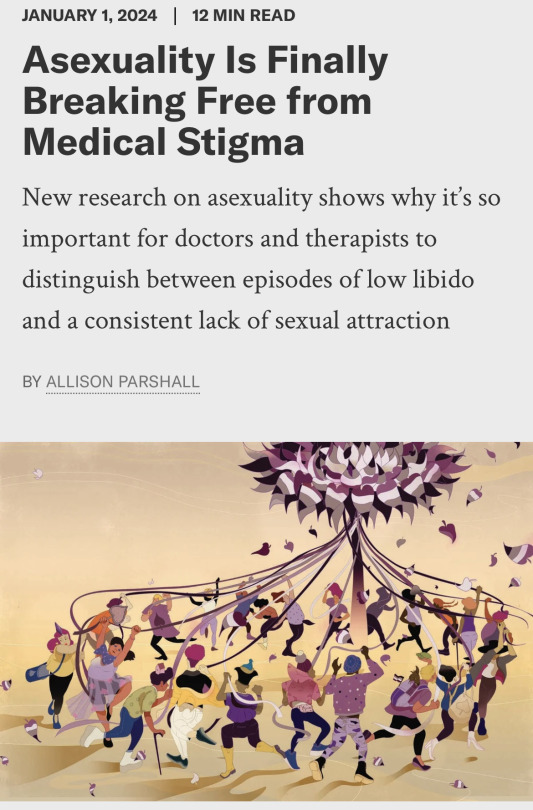
ACES!!! Look at this Scientific American article!!! It makes me genuinely so happy to read. We’re making it!!!!
https://www.scientificamerican.com/article/asexuality-is-finally-breaking-free-from-medical-stigma/
#asexual#demisexual#ace pride#queer#lgbtq#aromantic#aroace#GUYS READ IT PLEASE IM SO HAPPY!!!#update y’all check notes for the time traveling! I’m very honored ppl think I’m some ace time traveling god though. just for science article
35K notes
·
View notes
Text
Hi. I just wanna say that queer readings are equally as valid as straight readings. Both are interpretations of the text. Different interpretations of the text is a GOOD thing actually. It leads to a broadening of the mind, not to mention better reading skills. Also, interpreting characters as lgbtqia+ or as cishetallo as you wanna see them is fun! They can coexist. We can all share in the joy. It's not "why do you have to make everything gay?" It's "this is your equally valid interpretation of the text even if I choose to read it differently." Be excellent to each other. Party on, dudes!
1 note
·
View note
Text
I love how intricate asexuality can be. No sex at all? Sure! Just want to watch? Brilliant! Only comfortable with topping? You go girl! Only rarely feel aroused and when you do it's very touch and go? Wonderful! Kinky but not in a sex way? Coolio! Queerness is full of nuance and people are complicated and things never live in a vacuum!!
#guess what made this dawn on me#reading jmart fanfic#and seeing all the different ways jon's asexuality is depicted#it just makes me so happy about the queer community#tma#the magnus archives#jonathan sims#martin k blackwood#jmart#queer#ace#asexual#acespec
16K notes
·
View notes
Text
Normalize letting trans kids live.
Every trans child on this planet deserves to be safe & supported.
#text post#lgbtq#lgbt#trans#transgender#nonbinary#queer#gender queer#genderfluid#nex benedict#say their name & the name of every other trans people killed from hate#Nex deserved to grow up. And they deserved to feel safe at school. neither of those things will happen now.#when I first saw this story a couple days ago I was enraged to read that not only were they denied medical care they were also suspended
5K notes
·
View notes
Text
youtube
0 notes